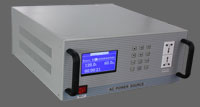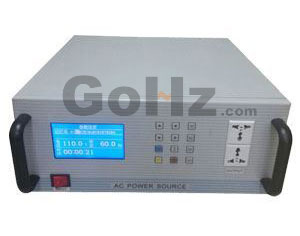Category

Understanding Static Frequency Converter
Static frequency converter means that's no rotary parts inside it - also called solid state - the definition is relative to rotary frequency converter which is using an electric motor to output adjustable frequency.

Static frequency converter is changing fixed grid power through AC to DC to AC by inner electronic parts and components, the multifunctional inverter converts the mains (50 Hertz or 60 Hertz, 120V, 240V, 400V) through conversion circuit and transforms into the required voltage and frequency power source, the output power source can simulate international power system standards. Enter a single or three phase AC power, convert via ac to dc, dc to ac, the output is stable pure sine wave, and also can output 400 Hertz in aircraft industry.
In order to adapt to the trend of the times of the power of green environmental protection, the static frequency converter adopts the advanced PWM (Pulse Width Modulation) technology, and the international famous brand advanced IGBT power module as drive, has small volume, high reliability, low noise characteristics. Static frequency converter using digital signal processing technology can provide voltage, frequency, current, power factor etc. precise data; The large capacity IGBT module design and special driving circuit for IGBT can effectively reduce the complexity of the circuit, and to improve the reliability and stability of the static frequency converter; Input and output electrical completely isolated, anti-jamming and security of the engine. The converter can provide single phase voltage is 0 ~ 300v, three-phase (0 ~ 520v) and frequency of 40 ~ 499.9 Hz, adopting programmable frequency refers to the set.

How to choose a static frequency converter?
GoHz static frequency converter can convert 60Hz to 50Hz, also can boost 110V to 220V by built-in step up transformer, vice versa. Before you buying a static frequency converter, it's better to understand what kinds of loads the converter will be connected with. There are five common load forms: 1, resistive load; 2, inductive load; 3, capacitive load: 4, rectifier load; 5, regenerative load; 6, mixed loads. We should choose the static converter power capacity according to the load capacities and types.
Static frequency converter sizing
GoHz solid state frequency converters do not have special requirements for the load types, they can be used for resistive, inductive, capacitive, rectification and mixed loads. The technical parameters are tested based on standard rated resistive load conditions, these static frequency converters can in long-running under these conditions. But taking into account of the power grid voltage fluctuation, inrush current and short-time overload factors, we should keep an appropriate margin in power capacity selection of the converter. Here are some recommendations by the manufacturer:
Resistive load: Power Capacity = 1.1 × load power capacity.
RC load: Power Capacity = 1.1 × load apparent power capacity.
Motor load: The motor starting current will be approx. 5 - 7 times of the rated current in case of hard start (direct start), the starting time is usually within 2 seconds. The static frequency converter overload capacity is generally 200% within 2 seconds before it triggering overload protection. Therefore, considering the starting capacity, it is recommended to select a solid state converter power capacity 3 times higher than the motor capacity if the motor is hard starting, otherwise, you'd better to install a soft starter or frequency inverter for the motor.
Rectifier load: the input circuit includes a rectifier diode (or thyristor) and filter capacitors, if the input circuit has no soft start device, the load can be treated as short circuit during the input switch closing moment, which will generate a huge impact current to trigger the static converter over-current protection. If there is frequent large starting inrush current, it will also affect the load circuit. Therefore, the rectifier load input circuit should adopt soft start measures to limit the starting current.
Since the rectifier load's current is pulse current, the current crest factor is up to 3 - 3.5 times, so it will affect the output voltage waveform in long-run, the impact is depended on the load's current crest factor. Generally, when the current crest factor > 2:00, choose the solid state frequency converter power capacity by following formula: Power capacity = load current crest factor / 2 × load apparent power.
Regenerative load: such as reversible motor, variable speed motor loads, there will be a high back EMF during the the motor reverses to damage the static converter easily, please be specified before ordering the frequency converter for such loads.
Mixed load: consider the proportion of each load power capacity to select a proper static frequency converter.
Note: Factory default input voltage is 220V for single phase, 380V for three phase, 60Hz or 50Hz. If you need to change the input voltage or have special requirements, please be specified during ordering.

Static frequency converter is changing fixed grid power through AC to DC to AC by inner electronic parts and components, the multifunctional inverter converts the mains (50 Hertz or 60 Hertz, 120V, 240V, 400V) through conversion circuit and transforms into the required voltage and frequency power source, the output power source can simulate international power system standards. Enter a single or three phase AC power, convert via ac to dc, dc to ac, the output is stable pure sine wave, and also can output 400 Hertz in aircraft industry.
In order to adapt to the trend of the times of the power of green environmental protection, the static frequency converter adopts the advanced PWM (Pulse Width Modulation) technology, and the international famous brand advanced IGBT power module as drive, has small volume, high reliability, low noise characteristics. Static frequency converter using digital signal processing technology can provide voltage, frequency, current, power factor etc. precise data; The large capacity IGBT module design and special driving circuit for IGBT can effectively reduce the complexity of the circuit, and to improve the reliability and stability of the static frequency converter; Input and output electrical completely isolated, anti-jamming and security of the engine. The converter can provide single phase voltage is 0 ~ 300v, three-phase (0 ~ 520v) and frequency of 40 ~ 499.9 Hz, adopting programmable frequency refers to the set.

How to choose a static frequency converter?
GoHz static frequency converter can convert 60Hz to 50Hz, also can boost 110V to 220V by built-in step up transformer, vice versa. Before you buying a static frequency converter, it's better to understand what kinds of loads the converter will be connected with. There are five common load forms: 1, resistive load; 2, inductive load; 3, capacitive load: 4, rectifier load; 5, regenerative load; 6, mixed loads. We should choose the static converter power capacity according to the load capacities and types.
Static frequency converter sizing
GoHz solid state frequency converters do not have special requirements for the load types, they can be used for resistive, inductive, capacitive, rectification and mixed loads. The technical parameters are tested based on standard rated resistive load conditions, these static frequency converters can in long-running under these conditions. But taking into account of the power grid voltage fluctuation, inrush current and short-time overload factors, we should keep an appropriate margin in power capacity selection of the converter. Here are some recommendations by the manufacturer:
Resistive load: Power Capacity = 1.1 × load power capacity.
RC load: Power Capacity = 1.1 × load apparent power capacity.
Motor load: The motor starting current will be approx. 5 - 7 times of the rated current in case of hard start (direct start), the starting time is usually within 2 seconds. The static frequency converter overload capacity is generally 200% within 2 seconds before it triggering overload protection. Therefore, considering the starting capacity, it is recommended to select a solid state converter power capacity 3 times higher than the motor capacity if the motor is hard starting, otherwise, you'd better to install a soft starter or frequency inverter for the motor.
Rectifier load: the input circuit includes a rectifier diode (or thyristor) and filter capacitors, if the input circuit has no soft start device, the load can be treated as short circuit during the input switch closing moment, which will generate a huge impact current to trigger the static converter over-current protection. If there is frequent large starting inrush current, it will also affect the load circuit. Therefore, the rectifier load input circuit should adopt soft start measures to limit the starting current.
Since the rectifier load's current is pulse current, the current crest factor is up to 3 - 3.5 times, so it will affect the output voltage waveform in long-run, the impact is depended on the load's current crest factor. Generally, when the current crest factor > 2:00, choose the solid state frequency converter power capacity by following formula: Power capacity = load current crest factor / 2 × load apparent power.
Regenerative load: such as reversible motor, variable speed motor loads, there will be a high back EMF during the the motor reverses to damage the static converter easily, please be specified before ordering the frequency converter for such loads.
Mixed load: consider the proportion of each load power capacity to select a proper static frequency converter.
Note: Factory default input voltage is 220V for single phase, 380V for three phase, 60Hz or 50Hz. If you need to change the input voltage or have special requirements, please be specified during ordering.
Sir, can you please explain the block diagram more clearly? or give reference to some text for static frequency conveter
Post a Comment:
You may also like:


I would like to buy a Static Frequency Converter with the following specifications;
input: 440v ac .60hz. 3 phase
output; 115v ac. 400hz. 1 phase. 550VA (5A)
Do you the product, prefer small size.
If you do not have the product , we will do it by our engineer provided we have a complete circuit diagram/schematic
Thank you and best regards